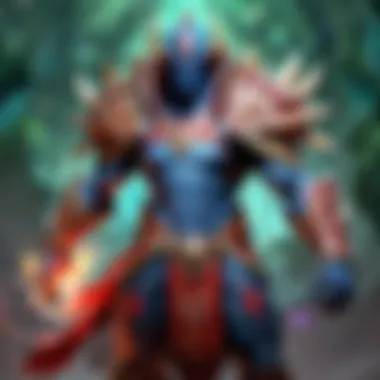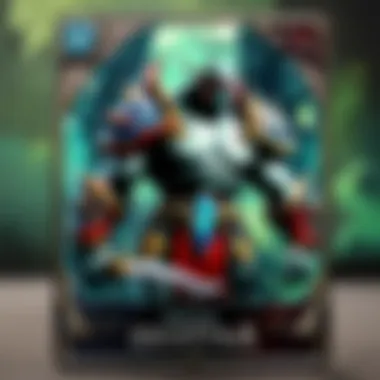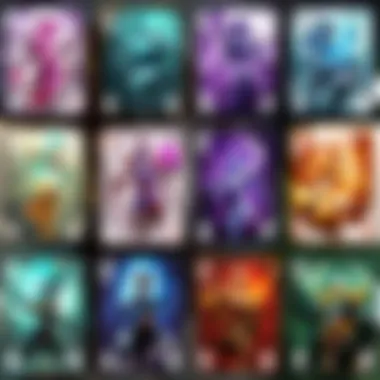Evaluating the Worth of Your Magic Cards: A Complete Guide


Intro
Assessing the value of your Magic: The Gathering cards is not a simple task. Several variables come into play. Furthermore, both seasoned players and new collectors can often be perplexed about how to determine the worth of their cards. The collectible card market has distinct characteristics that can significantly affect card prices.
In this guide, we will highlight essential aspects of card valuation. Topics will include scarcity, condition, demand in the current market, and how recent trends impact the worth of Magic cards. By comprehending these elements, individuals can make informed decisions whether buying, selling, or trading.
Magic: The Gathering engages enthusiastic fans who enjoy the excitement of tactical gameplay paired with collectible opportunities. This document aims to provide clarity on navigating the intricacies of card valuation effectively.
Let's venture into the world of Magic card evaluations, starting with understanding rarity—a fundamental aspect of what determines the appeal and worth of a card.
Rarity and its Impact on Value
The rarity of Magic cards truly influences their perceived value in the market. Cards fall into various categories based on how frequently they are produced. Several key types of rarity exist:
- Common: These are found in large quantities and represent the backbone of many sets.
- Uncommon: Less prevalent than commons but still available in moderate numbers.
- Rare: These cards are much harder to obtain and typically have unique abilities or themes
- Mythic Rare: Often the most sought-after, these cover the most powerful gameplay aspects or represent popular characters or stories.
As you assess a card's rarity, be sure to research its set features. Some sets are notorious for many strong or iconic rare and mythic rare cards, affecting overall market demands.
Card Condition: A Critical Factor
The condition of Magic cards holds critical importance and can heavily sway pricing. Cards are conventionally rated from Mint, near Mint, Lightly Played, Moderately Played, to Heavily Played. Each gradation informs potential buyers about a card’s quality.
A quick breakdown of conditions includes:
- Mint: No visible blemishes; appears freshly packed.
- Near Mint: Minor imperfections are possible but not easily spotted.
- Lightly Played: Some signs of wear but still maintains appeal for collectors.
- Moderately Played: More obvious wear that can impact display qualities.
- Heavily Played: Significant aesthetic damage presenting concerns in trading or competitive use.
Investors tend to seek cards graded by official grading companies to assure condition consistency. Understanding grades can be beneficial in evaluating and justifying price expectations.
Demand and Market Trends
The demand for specific Magic cards is not static; it fluctuates based on current gameplay trends, local meta, and card synergies and counters. Seasonal updates and set releases often drive social conversation, directly affecting interest in various cards. It is wise to observe community discussions on platforms like Reddit to gain insight into trending cards and shifts in demand.
Particular categories of players, such as casual players or competitive tournament attendees, might drive up values for certain cards more than others. Unique ability cards or cards providing key functionality can enter high-value cycles based on emerging strategies or deck compositions.
End
Understanding Card Value
Understanding the worth of your Magic: The Gathering cards is essential for both seasoned collectors and newcomers. Value can fluctuate widely, influenced by several factors such as rarity, condition, and demand. Each variable adds a layer of complexity when deciding whether to trade, sell, or hold onto your cards. Grasping these elements allows you to strategize better within the competitive marketplace. A well-informed assessment can significantly enhance your collections' financial potential.
What Constitutes Value?
Value in the context of Magic cards is not limited solely to the numerical price listed on various marketplaces. Instead, it encompasses multiple dimensions. The interplay between rarity, condition, and current demand serves as the foundational triad for understanding card value.
Key Terms to Know
- Rarity: Rarity refers to the scarcity of a card within its set. This aspect profoundly impacts its attractiveness and perceived worth. Cards labeled as rare or mythic rare inherently command higher initial values— their limited availability often triggers competition among collectors. Hence, understanding rarity provides a strategic edge in evaluating potential transactions. In a market saturated with options, these rarities can amplify a card's overall desirability.
- Condition: Condition is pivotal in the overall valuation. It indicates the physical state of the card, categorized typically into several grades ranging from mint to poor. Higher graded cards fetch better prices, resulting from protective measures during gameplay and storage conditions. Awareness of how condition influences the market ensures more informed decision-making.
- Demand: Demand refers to how sought after a card is in the current market. High-demand cards can sell at significantly higher prices regardless of their base rarity. Factors influencing demand include format playability and competitive meta relevance. An understanding of market trends can provide insights into future valuations.
Understanding these key aspects—rarity, condition, and demand—will lead to more informed choices in the arena of card trading, enhancing your profitability and enjoyment in collecting.
Rarity of Cards
Rarity is one of the most important factors when evaluating the worth of Magic: The Gathering cards. It affects both the market value and collectors' interest. Cards are categorized based on their rarity, which influences how many copies exist and how sought-after they become. Understanding these categories can greatly assist any player or collector in making informed decisions. Rarity not only impacts current value but the potential for future appreciation as well.
Types of Rarity


Common
Common cards are the most abundant within most Magic sets. They often serve as the building blocks for decks, providing essential mechanics and support. Their key characteristic is that they are printed in larger quantities compared to other rarities. Because of this, they are generally not very valuable in terms of market price.
However, Common cards have certain unique features. For beginners, they are often the first cards acquired, establishing an initial understanding of card mechanics and strategies. The advantage of Commons lies in their availability; players can easily obtain them without significant costs.
Uncommon
Uncommon cards usually appear less frequently than Common ones but more than Rare and Mythic Rare cards. This scarcity makes them more valuable. Commons often find themselves under cheaper, and Uncommons occupy a mid-range in pricing. The distinctive feature of Uncommon cards is their depth: many are integral for strategies, enabling combos or synergies that enhance gameplay.
The advantage is clear. Skilled players turn to Uncommon selections for unique strategies that elevate their decks beyond mere foundational builds. They possess better qualities than Common cards while maintaining reasonable accessibility.
Rare
Rare cards are much less common, leading to higher market values. The quantity of each Rare card decreases significantly compared to both Common and Uncommon variants. Their equality means that potential resale or trade comparisons can inflate audacious offers among collectors and serious players alike. Critical pricing characteristics stem from their limited availability in booster packs and overall demand.
Rares are often highly coveted for their powerful effects or exclusive thematic alignments. This makes them attractive assets to hold or trade, providing both collectors and players a potent option for strategic dominance or monetary gain. However, risk of counterfeiting becomes greater the rarer they become, requiring extra verification during sales.
Mythic Rare
The pinnacle of card rarity, Mythic Rare cards are exceedingly scarce and often yield the highest market values. Most sets feature only a select few of these ties. Players often view their inclusion in a collection as a significant asset, alongside their vast influence on gameplay strategy. The essential characteristic of Mythic Rares is that each set features only one in every several packs inherently excessive supply.
The notable advantage here is their broad collectibility and representation in major tournament level decks due to their often game-changing abilities. However, with great power comes limitations; their scarcity may mean high upfront costs for newcomers to Magic without significant card trading experience.
Set Editions and Their Impact
Different set editions radically impact the rarity valuation of cards. Specialty sets or older editions often yield cards that collectors particularly find appealing, altering their price significantly. Besides simple rarity, the anime adaptation or artistry may attract secondary market buyers, further complicating potential profitability paths. Evaluate your cards based on editions once collecting escalates.
More details about these conditions can often be discussed in forums or communities dedicated to your interest in pricing sets and cards on platforms like reddit.com.
The volatile dynamics of card value remind players and collectors how essential analyzing rarity really is, not just intellectually but as a monetary investment strategy.
Assessing Card Condition
Evaluating the condition of your Magic cards is crucial in determining their market value. The state of a card has a direct influence on how collectors and players perceive its worth. Cards in pristine condition can command significantly higher prices compared to those with visible wear and tear. As such, understanding how to assess condition not only aids in effective buying and selling but also preserves the investment you have in your collection. Additionally, grading can provide clarity in the often-subjective world of card valuation.
Grading Scales Explained
Grading scales serve as a standardized way to classify card conditions. The most recognized grading companies utilize numerical systems to rate cards. Here are some widely accepted ratings:
- Gem Mint (10): Perfect card, no visible flaws under 10x magnification
- Mint (9): Almost perfect but may have minor flaws
- Near Mint (8): Slight imperfections visible upon close inspection
- Excellent (7): More pronounced wear, edges beginning to show some damage
These scales help potential buyers assess whether a card meets their criteria. Using consistent grades aids in matching expectations between buyers and sellers, paving the way for smoother transactions. Remember to keep in mind that personal inspections can also add value to the gradings given.
How to Properly Inspect Your Cards
Inspecting your Magic cards correctly is essential for accurate assessment. Start by analyzing several aspects:
- Surface Scratches: Check for any fine lines, which can detract from the card’s overall appeal.
- Edges and Corners: Undamaged corners and flush edges indicate a higher quality card. Even minor imperfections can lower a card's grade significantly.
- Centering: The alignment of the printed image matters greatly in grading. Well-centered cards often hold more value.
Keep a dedicated space for card evaluation with good lighting. Proper handling of your cards using protective gloves also minimizes risks of damaging the surface. Each minor detail adds to the final valuation of your cards, influencing the bidding and negotiation process.
Invest time in inspecting your cards well. The investment will yield rewarding returns in the future!
Understanding card condition goes far beyond surface appearance. An informed insight into your collection can reinforce your position either as a buyer or a seller within the ever-evolving Magic card market.


Market Trends and Demand
Understanding this section is crucial to your journey in evaluating Magic: The Gathering cards. Market trends and demand play a substantial role when determining not just an individual card's value, but also the overall landscape of investments in collectibles. With the rapid evolution of the game and its player base, card values can fluctuate greatly. Recognizing these trends helps both collectors and investors. It leads to informed decisions, allowing one to capitalize on rising cards or avoid downturns that could diminish overall worth.
Understanding Market Fluctuations
Market fluctuations for Magic cards are influenced by various factors. Player interest, tournament results, and general economic conditions frequently shift values. The cards see different demands depending on the current meta, that is, the prevailing strategies and favorite decks. Understanding when to buy or sell requires consistent monitoring of these trends. For instance, a sudden spike in a card's popularity due to a successful tournament deck can increase its value drastically. On the other hand, overproduced sets may see a decline in demand over time. Hence, staying updated is vital for anyone involved in buying or selling these cards.
Identifying Popular Cards
Recognizing popular cards can lead to substantial financial rewards. Popularity can stem from their effectiveness in gameplay or iconic status in the community. Two integral aspects to the popularity of these cards are their meta impact and collectibility.
Meta Impact
Meta Impact involves the effectiveness of certain cards in gameplay scenarios. Cards that become part of winning tournament decks often experience surges in value. The community’s perception of desirability concludes how few must-have cards can dominate the meta. Cards that show strong performance bend the overall demand landscape. Successful builds lead to heightened trading for those key components. As a result, they showcase market stability aligned with present player strategy.
Collectibility
Collectibility addresses how much a card is desired within collectibles for various reasons. Cards with deep lore, limited editions, or striking artwork attract attention outside gameplay. Players seek to complete sets or possess iconic pieces. Collectors may opt for cards originating from specific eras or important expansions.
Collectibility impacts price as it ties symbols of nostalgia to their worth. The challenge, however, rests with supply. If many players share the same pursuit, card values can become unpredictable, heavily dependent on modes of supply and distribution.
Collectors do need to balance this with practicality. While they may pursue passion over profit, understanding collectible cards with shifted environmental significance crucially gears any strategy for worth retention.
Pay attention to shifts in gameplay preferences as they directly influence demand and price trends.
Resources for Valuation
Understanding various platforms and communities available for Magic: The Gathering card valuation is crucial. This knowledge allows collectors and investors to make informed decisions based on accurate metrics. Online tools and community insights can provide real-time data that directly influences pricing and demand.
Online Marketplaces and Pricing Guides
TCGPlayer
TCGPlayer is a well-known online marketplace essential for card valuation. Its primary function is that it collects and analyzes card prices from numerous sellers, providing players with a detailed overview of current market rates. A key characteristic of TCGPlayer is its user-friendly interface, where listings show price trends over time. This feature assists users in understanding fluctuations for specific cards covering different formats and editions.
One unique aspect of TCGPlayer is its extensive price database. It allows collectors to track historical pricing which can inform their buying and selling strategies. Another advantage lies in the purchase protection it offers, ensuring both buyers and sellers feel secure during transactions.
Improved pricing visibility is a significant benefit; however, some collectors may encounter slightly higher fees compared to other platforms, which could impact sale profitability.
CardMarket
CardMarket is another prominent marketplace, particularly popular in Europe. Its focus lies in the community-driven approach to trading and buying cards. An important feature of CardMarket is the ability to directly communicate with sellers, fostering an engaging environment for trading. The customer-oriented structure makes it notably appropriate for those who prioritize building ongoing relationships in discussion groups or trading communities.
CardMarket also includes a dedicated pricing guide section that allows users to observe price shifts for their collector targets throughout different periods. One major venturesome of CardMarket is its extensive selection of titles, addressing various languages and regional interests which often lets you find cards specific to local markets.
Some disadvantages include potential language barriers and regional payment issues, affecting ease of use for users from different places.
Community Forums and Discussions
Engaging in community forums enhances understanding of your card values. Places like reddit.com have subreddits covering the maritime offering intuitive tools in discussions, providing complimentary insights from experienced players. Forums often address trends and upcoming cards likely to affect school, fully nourishing participants in their strategic approaches. These can significantly illuminate aspects of market demand that raw data alone doesn't reveal. Regular participation will extend one’s knowledge and foster constructive dialogues within the community.
Selling Your Cards
Selling your Magic: The Gathering cards is an important aspect of the collecting experience. Properly evaluating their worth and finding ways to effectively sell can maximize your returns and help you manage your collection effectively. Many factors come into play, including where to sell and how to present your cards attractively to potential buyers. Understanding these aspects elevates your selling strategy, making the entire process more profitable and efficient.


Best Platforms for Selling
Ebay
Ebay is one of the primary platforms for selling Magic cards. This platform offers a vast audience of potential buyers, making it a top choice for many sellers. The auction feature allows individuals to set a starting price and let the market determine the final selling price. This dynamic can drive up the value of sought-after cards. One key characteristic of Ebay is that it facilitates both auction and fixed-price listings. This flexibility allows sellers to choose their preferred selling method based on their card's value situation.
However, there are also disadvantages. Sellers should be aware of listing fees and the percentage that Ebay takes from completed sales. So it is wise to factor in these costs when evaluating your total return. Furthermore, competition is fierce; many sellers contribute to the dynamic which can an impact pricing.
Facebook Marketplaces
Facebook Marketplaces is a growing option for selling Magic Cards. Many find this platform appealing because it connects you with local buyers directly. One distinct aspect of Facebook Marketplaces is that individual sellers can set their prices without significant overhead or platform fees. This makes it financially attractive for many collectors looking to sell their extras. Sellers can make arrangements for direct cash payments, avoiding shipping complications which can be convoluted.
Nonetheless, buyers expect speed and assurance about what they purchase. The need for trustworthy communication is essential. If the card condition is misrepresented, this can lead to unsatisfactory deals, damaging your reputation as a seller. Consequently, presentation and a reliable demeanor matter heavily in this marketplace.
Tips for Maximizing Your Price
Selling Magic cards with the intent of maximizing price requires effort and strategy. Here are some tips:
- Research current market trends: Stay updated on what similar cards are selling for. Using price tracking systems deepens your understanding of the card's value.
- Good Photographs Matter: High-quality images increase buyer confidence. Ensure your cards are well-lit and shown at proper angles.
- Word Descriptions Count: Provide a detailed description of your cards. Mention specifics about the card's condition, rarity, and any unique features.
- Smart Timing matters: Pay attention to market trends. Sell cards during peaks in their popularity, such as after a new game release or when cards are heavily featured.
- Post in relevant communities: Sharing your listing across the Magic community can attract more attention. Connects with local buyer groups for firearm sales can increase visibility.
Proper evaluation, effective selling techniques, and smart tactics can significantly enhance your trading experience.
Selling your Magic cards is not just about off-loading duplicates; it is an opportunity for growth within your collection strategy and can yield profitable returns when done correctly.
Preservation and Care
Preserving and caring for your Magic: The Gathering cards is as vital as understanding their value or rarity. Without appropriate handling and storage, even the rarest or most valuable cards can deteriorate and lose their worth. There are specific elements and considerations that come into playwhen we discuss preserving card quality. Attention to detail can greatly determine the longevity of your collection.
Protective Sleeves and Storage
Using protective sleeves is an essential measure for keeping your cards in optimal condition. Sleeves act as the first line of defense against dust, fingerprints, moisture, and other contaminants that may harm the card. Some key points to consider include:
- Material: Choose sleeves made of high-quality, acid-free plastic. This prevents chemical reactions that can damage the cards.
- Types: Consider purchasing different types of sleeves based on what best suits your needs, such as gloss for display or matte for handling.
- Storage solutions: Store your sleeved cards in rigid storage boxes or binders with sturdy pockets. Make sure they fit securely but do not stretch.
It’s well advised not to leave your cards exposed or unprotected for long periods, especially if they are rare or valuable. Instead, greet moisture and heat with caution, as these are enemies to your card health.
Avoiding Damage and Wear
Understanding how to avoid damage is important when discussing card integrity. Even with sleeves, if handled incorrectly, cards can sustain unsightly wear. Here are best practices to prevent this:
- Handling: Always handle cards by the edges, not the faces, to prevent fingerprints or oils from transferring. This ensures the central print remains clean.
- Transportation: When moving cards, transport them in secure holders to prevent bends and creases. Folded pictures may look appealing for activities, but they absolutely truncate a card’s value.
- Environmental Factors: Keep your cards in a stable environment, away from heat sources, direct sunlight, and extremes in humidity. These factors can warp and fade your cards over time.
Proper preservation is not just a practice; it's a commitment to maintaining your investment.
Establishing good storage habits reaps benefits. Clearly labeled boxes and a systematic organization ensure you easily access your cards without disruption. In a competitive environment where every card’s worth can fluctuate, you want to ensure yours retain their appeal and, importantly, their value.
Long-Term Investment Potential
Long-term investment potential in Magic: The Gathering cards is an intricate aspect that deserves careful consideration. While instant rewards motivate many players, those who examine the value of cards over time stand to gain significantly. Understanding the long-term aspect not only enhances the value of your collection but provides insight into market stability and future trends.
The intricacies of the collectible card market are influenced by several critical factors. First and foremost, some cards grow in significance and monetary value as they become rare over the years. The passing of time, combined with a growing interest in the game, fuels demand for these particularly elusive items. Consequently, cards once overlooked may become sought after collectors’ items.
Benefits of Long-Term Investing:
- Potential for substantial financial returns
- Ability to make informed decisions regarding which cards to hold
- Enhanced knowledge of market trends and player interests
Beyond simple financial gratification, engaging with long-term strategies in card valuation deepens your understanding of the game itself. You develop insights into which cards have the potential to capture the interest of newer players, thus preserving or even enhancing your cards' marketability in the future. Identifying and choosing valued cards can be likened to building a portfolio.
Considerations About Long-Term Investment:
- Market Volatility: Understanding that the card market can experience unpredictable swings allows enthusiasts to mitigate risks.
- Meta Evolution: Staying attuned to changing game mechanics can assist in predicting which cards will be useful downthe road. New expansions and player strategies will affect demand.
- Condition Matters: Well-preserved cards always maintain greater worth compared to handled cards with wear. Ensure good storage and conditions to protect your investments.



